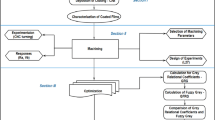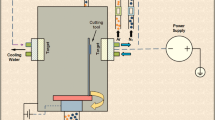Abstract
The key objective of this research study is to examine the performance of TiAlSiN coated insert while performing dry machining of AISI 420 martensitic stainless steel on quantified output responses. This paper seeks to optimize process parameters namely speed, feed, and depth of cut during turning process, such as surface roughness, flank wear, and material removal rate simultaneously. TiAlSiN thin film was coated on the carbide tool through high power impulses magnetron sputtering. To confirm the existence of coated elements, SEM and XRD studies were performed. For coated and pure inserts, microhardness was measured, whereas the TiAlSiN coated tool possesses 43.34% higher than pure inserts. The dry machining was performed with three process parameters, each in three phases. The experimentation was performed based on Taguchi’s design of experiments (DoE). In this study, a Multi-Criteria decision making (MCDM) approach encompassing Data Envelopment Analysis based Ranking Methodology (DEAR) with Taguchi’s design was applied. The multi-response performance index (MRPI) was calculated and their impact on the machining parameters was scientifically examined. The parameter combination of cutting speed: 240 m/min; feed rate: 0.20 mm/rev and depth of cut: 0.50 mm was observed to be the optimal input parameters.
Similar content being viewed by others
Data Availability
Included in the manuscript.
References
Sharma N, Gupta K (2019) Influence of coated and uncoated carbide tools on tool wear and surface quality during dry machining of stainless steel 304. Mater Res Exp 6(8):086585
El-Tamimi AM, Soliman MS, El-Hossainy TM, Muzher JA (2010) Developed models for understanding and predicting the machinability of a hardened martensitic stainless steel. Mater Manuf Process 25(8):758–768. https://doi.org/10.1080/10426910903447337
Benardos P, Vosniakos G-C (2003) Predicting surface roughness in machining: a review. Int J Mach Tools Manuf 43(8):833–844
Asiltürk I, Neşeli S (2012) Multi response optimisation of CNC turning parameters via Taguchi method-based response surface analysis. Measurement 45(4):785–794
El-Tamimi A, El-Hossainy T (2008) Investigating the machinability of AISI 420 stainless steel using factorial design. Mater Manuf Process 23(4):419–426
Noordin M, Venkatesh V, Sharif S (2007) Dry turning of tempered martensitic stainless tool steel using coated cermet and coated carbide tools. J Mater Process Technol 185(1–3):83–90
Ucun İ, Aslantaş K, Gökçe B, Bedir F (2014) Effect of tool coating materials on surface roughness in micromachining of Inconel 718 super alloy. Proc Inst Mech Eng B J Eng Manuf 228(12):1550–1562
Akhtar W, Sun J, Chen W (2016) Effect of machining parameters on surface integrity in high speed milling of super alloy GH4169/Inconel 718. Mater Manuf Process 31(5):620–627
Ibrahim GA, Che Haron CH, Ghani JA, Yazid A, Zaid M (2011) Performance of PVD-coated carbide tools when turning Inconel 718 in dry machining. Advances in Mechanical Engineering (Hindawi Publishing Corporation) 3
Sui X, Li G, Qin X, Yu H, Zhou X, Wang K, Wang Q (2016) Relationship of microstructure, mechanical properties and titanium cutting performance of TiAlN/TiAlSiN composite coated tool. Ceram Int 42(6):7524–7532
Jiang C, Zhu H, Shin K, Tang Y (2017) Influence of titanium interlayer thickness distribution on mechanical properties of Ti/TiN multilayer coatings. Thin Solid Films 632:97–105
Li G, Li L, Han M, Luo S, Jin J, Wang L, Gu J, Miao H (2019) The performance of TiAlSiN coated cemented carbide tools enhanced by inserting Ti interlayers. Metals 9(9):918
Kouznetsov V, Macak K, Schneider JM, Helmersson U, Petrov I (1999) A novel pulsed magnetron sputter technique utilizing very high target power densities. Surf Coat Technol 122(2–3):290–293
Anders A (2014) A review comparing cathodic arcs and high power impulse magnetron sputtering (HiPIMS). Surf Coat Technol 257:308–325
de Monteynard A, Schuster F, Billard A, Sanchette F (2017) Properties of chromium thin films deposited in a hollow cathode magnetron powered by pulsed DC or HiPIMS. Surf Coat Technol 330:241–248
Wang Z, Zhang D, Ke P, Liu X, Wang A (2015) Influence of substrate negative bias on structure and properties of TiN coatings prepared by hybrid HIPIMS method. J Mater Sci Technol 31(1):37–42
Vignesh V, Ilangovan S, Radhika N (2020) Statistical analysis of process parameters in drilling of SS410 stainless steel. Materials Today: Proceedings
Garg A, Lam JSL (2016) Modeling multiple-response environmental and manufacturing characteristics of EDM process. J Clean Prod 137:1588–1601
Kumar H, Ilangovan S, Radhika N (2020) Optimization of cutting parameters for MRR, tool wear and surface roughness characteristics in machining ADC12 piston alloy using DOE. Tribol Ind 42(1):32–40
Shankar S, Mohanraj T, Pramanik A (2019) Tool condition monitoring while using vegetable based cutting fluids during milling of Inconel 625. J Adv Manuf Syst 18(04):563–581
Sumesh CS, Ramesh A (2018) Numerical modelling and optimization of dry orthogonal turning of Al6061 T6 alloy. Period Polytech Mech Eng 62(3):196–202. https://doi.org/10.3311/PPme.11347
Mohanraj T, Ragav P, Gokul E, Senthil P, Anandh K (2021) Experimental investigation of coconut oil with nanoboric acid during milling of Inconel 625 using Taguchi-Grey relational analysis. Surf Rev Lett:2150008. https://doi.org/10.1142/s0218625x21500086
Moganapriya C, Rajasekar R, Kumar PS, Mohanraj T, Gobinath V, Saravanakumar J (2020) Achieving machining effectiveness for AISI 1015 structural steel through coated inserts and grey-fuzzy coupled Taguchi optimization approach. Struct Multidiscip Optim:1–18
Muthuramalingam T, Mohan B (2014) Application of Taguchi-grey multi responses optimization on process parameters in electro erosion. Measurement 58:495–502
Saravanakumar D, Mohan B, Muthuramalingam T (2014) Application of response surface methodology on finding influencing parameters in servo pneumatic system. Measurement 54:40–50
Deepanraj B, Sivasubramanian V, Jayaraj S (2017) Multi-response optimization of process parameters in biogas production from food waste using Taguchi–Grey relational analysis. Energy Convers Manag 141:429–438
Jaddi NS, Abdullah S (2017) A cooperative-competitive master-slave global-best harmony search for ANN optimization and water-quality prediction. Appl Soft Comput 51:209–224
Gokulachandran J, Padmanaban R (2018) Prediction of remaining useful life of cutting tools: a comparative study using soft computing methods. Int J Process Manag Benchmarking 8(2):156–181
Manoj M, Jinu G, Muthuramalingam T (2018) Multi response optimization of AWJM process parameters on machining TiB 2 particles reinforced Al7075 composite using Taguchi-DEAR methodology. Silicon 10(5):2287–2293
Muthuramalingam T, Vasanth S, Vinothkumar P, Geethapriyan T, Rabik MM (2018) Multi criteria decision making of abrasive flow oriented process parameters in abrasive water jet machining using Taguchi–DEAR methodology. Silicon 10(5):2015–2021
Huu Phan N, Muthuramalingam T (2020) Multi criteria decision making of vibration assisted EDM process parameters on machining silicon steel using Taguchi-DEAR methodology. Silicon. 13:1879–1885. https://doi.org/10.1007/s12633-020-00573-4
Moganapriya C, Rajasekar R, Ponappa K, Venkatesh R, Karthick R (2017) Influence of cutting fluid flow rate and cutting parameters on the surface roughness and flank wear of TiAlN coated tool in turning AISI 1015 steel using Taguchi method. Arch Metall Mater 62(3):1827–1832
Jose F, Ramaseshan R, Dash S, Jain D, Ganesan V, Chandramohan P, Srinivasan M, Tyagi A, Raj B (2011) Significance of Al on the morphological and optical properties of Ti1− xAlxN thin films. Mater Chem Phys 130(3):1033–1037
Chen L, Du Y, Wang AJ, Wang SQ, Zhou SZ (2009) Effect of Al content on microstructure and mechanical properties of Ti–Al–Si–N nanocomposite coatings. Int J Refract Met Hard Mater 27(4):718–721
Feng C, Hu S, Jiang Y, Wu N, Li M, Xin L, Zhu S, Wang F (2014) Effects of Si content on microstructure and mechanical properties of TiAlN/Si3N4-Cu nanocomposite coatings. Appl Surf Sci 320:689–698
Moganapriya C, Rajasekar R, Ponappa K, Kumar PS, Pal SK, Kumar JS (2018) Effect of coating on tool inserts and cutting fluid flow rate on the machining performance of AISI 1015 steel. Mater Test 60(12):1202–1208
Zerti A, Yallese MA, Meddour I, Belhadi S, Haddad A, Mabrouki T (2019) Modeling and multi-objective optimization for minimizing surface roughness, cutting force, and power, and maximizing productivity for tempered stainless steel AISI 420 in turning operations. Int J Adv Manuf Technol 102(1–4):135–157
Acknowledgments
No funds, grants, or other support was received
Code Availability
Not applicable.
Author information
Authors and Affiliations
Contributions
All authors discussed the content of the article based on their domain expertise on the subjects presented. C. Moganapriya performed the experiments and analyzed the data through statistical approach. P. Sathish Kumar characterized the coatings through SEM and XRD. T. Mohanraj optimized the results through DEAR approach. V. K. Gobinath and C. Poongodi executed the confirmation experiment. C. Moganapriya drafted the paper and revised the manuscript. R. Rajasekar supervised the study and discussed the results, proofread the manuscript and confirmed its findings. All authors read and approved the final manuscript.
Corresponding author
Ethics declarations
Conflict of Interests
The author(s) declared no potential conflicts of interest concerning the research, authorship, and/or publication of this article.
Consent to Participate
Not applicable.
Consent for Publication
Not applicable.
Additional information
Publisher’s Note
Springer Nature remains neutral with regard to jurisdictional claims in published maps and institutional affiliations.
Rights and permissions
About this article
Cite this article
Moganapriya, C., Rajasekar, R., Mohanraj, T. et al. Dry Machining Performance Studies on TiAlSiN Coated Inserts in Turning of AISI 420 Martensitic Stainless Steel and Multi-Criteria Decision Making Using Taguchi - DEAR Approach. Silicon 14, 4183–4196 (2022). https://doi.org/10.1007/s12633-021-01202-4
Received:
Accepted:
Published:
Issue Date:
DOI: https://doi.org/10.1007/s12633-021-01202-4




